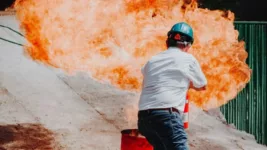It’s important not to grow complacent when it comes to fire safety in the workplace. In the event of a fire, even if no one is hurt, the business will still have to deal with the property damage the fire caused to the store and surrounding properties.
Here are some tips that can help minimize fire risks, and reduce the damage if a fire does occur.
1 – Regular inspections
It’s a good idea to have your business inspected for fire hazards every year, or every two years, depending on what types of hazards are found on the premises. A good inspector will be able to not only provide fire safety tips and take stock of potential fire hazards, but they will also be able to spot areas where the business may not be following current fire safety regulations.
2 – Keep an eye on fire hazards
Keep flammable material away from potential fire hazards. This sounds simple, but it requires that your businesses be able to keep track of what those hazards are, since it’s not always obvious what can and can’t lead to a fire.
In an office space, for example, the main potential fire hazard is electrical issues. Outlets can produce sparks if they are faulty, and sparks can be produced by damaged wires and cords that have wires exposed. “Isolation”, in this context, is as simple as making sure wires are properly protected, and no open trash cans are placed under wall outlets.
Other work environments deal with different hazards, from machinery that can overheat to industrial stoves that can ignite kitchen oil if left unattended. These require that employees be trained to identify initial signs of trouble and that the area around these fire hazards is kept clear of any flammable materials.
3 – Additional safety equipment
On top of the equipment required by your local fire codes, there is a variety of fire safety equipment that helps prevent and control fires. Installing smoke detectors, sprinkler systems, and additional fire extinguishers can all help make a workplace safer.
Two things should be taken into account here. First, additional equipment may do more harm than good if the staff isn’t properly trained — for example, the staff must know which type of fire extinguisher to use when dealing with different types of fire.
The second factor is age and maintenance. It can be tempting to buy equipment and forget about it, but sprinklers and extinguishers can all stop working if they aren’t properly maintained. The same fire sprinkler service that installed the system on your office space will probably also be able to do regular inspections and maintenance on the system, or they’ll be able to recommend someone who can.
4 – Have an evacuation plan
It’s not uncommon for people to end up injured not because of the fire, but because of something that happened during a panicked evacuation. Employees need to know to stay calm when a fire starts, and they need to know exactly where they should go during the evacuation process.
It’s also crucial to make sure that the chosen evacuation routes are kept clear of anything that could make the process more difficult. This means there should be no clutter located on the path to the safety exit or the staircase. A faulty door can also slow down the evacuation process.








